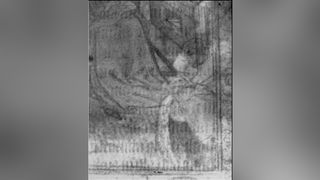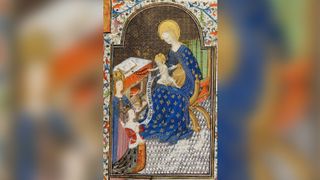Duke of Brittany hid image of dead wife in 15th-century prayer book

A hidden image in an ornately illustrated 15th-century prayer book reveals that the duke of Brittany at the time painted over an image of his dead wife with his then-current wife, researchers have found. The story behind the medieval "wife swap" is somewhat tragic.
This particular "Book of Hours," as such Christian devotional books were called, was commissioned in 1431 by Yolande of Aragon (1381-1442), who was the duchess of Anjou, in France. She gave it to her daughter Yolande of Anjou (1412-1440) when the daughter married Duke Francis I of Brittany in 1431. The couple had a son who died in childhood, and Yolande herself died in 1440.
Related: Cracking codices: 10 of the most mysterious ancient manuscripts
A page in the book has an area that looks darker and scientists with the Fitzwilliam Museum in Cambridge in the United Kingdom, which owns the manuscript, used near-infrared (NIR) imaging to image the dark spot. That imaging revealed that the book once included an image showing Yolande of Anjou kneeling in prayer before the Virgin Mary. However, that image had been painted over and replaced with one showing the duke's second wife, Isabella Stewart of Scotland (1427-1494), who is also shown kneeling in prayer before the Virgin Mary. An image of St. Catherine of Alexandria, a woman who was killed in the fourth century, is shown beside Isabella Stewart.

"At the death of his first wife, Francis may have taken control of the prayer book and ordered it to be customized to best suit Isabella," said Suzanne Reynolds, the curator of manuscripts and printed books at the Fitzwilliam Museum at the University of Cambridge. "It is possible Isabella had some input. For example, the inclusion of St. Catherine who was not there before indicates that Isabella may have had a special devotion to this saint," Reynolds told Live Science. Isabella's coat of arms was also painted on many of the book's pages.
Such "Books of Hours" were popular during the middle ages, but this is the only example that Reynolds is aware of in which an image of a new wife was painted over a late wife. Reynolds said that we know little about the relationship between the duke and Yolande of Anjou.
"We have no information about this. Yolande died young," said Reynolds, who noted that they were not divorced. "Even though it is 'secondhand,' this is still a spectacular gift, one of the most richly decorated 'Books of Hours' of the middle ages," Reynolds said. "The alterations are to customize and personalize the book for Isabella and also acknowledge the important royal family of Scotland of which she was part, by adding her coat of arms over the original border decoration."
Sign up for the Live Science daily newsletter now
Get the world’s most fascinating discoveries delivered straight to your inbox.
The book is now being displayed as part of the Fitzwilliam Museum's exhibition "The Human Touch," which runs from May 18 to Aug. 1, 2021. Reynolds is co-curator of the exhibition.
Originally published on Live Science.

Owen Jarus is a regular contributor to Live Science who writes about archaeology and humans' past. He has also written for The Independent (UK), The Canadian Press (CP) and The Associated Press (AP), among others. Owen has a bachelor of arts degree from the University of Toronto and a journalism degree from Ryerson University.
